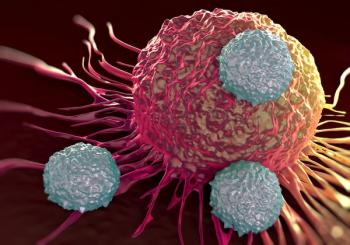
- ONCOLOGY Vol 16 No 5
- Volume 16
- Issue 5
Breakthrough Pain in Cancer Associated With Increased Medical Services and Costs
Investigators from Memphis found that cancer patients who experience breakthrough pain require additional medical services that result in higher medical costs than those incurred by cancer patients without breakthrough pain. The study, published in the February 2002 issue of the Journal of Pain, reported that patients with breakthrough pain (perhaps two-thirds of this population) require more frequent hospitalizations and doctor visits than cancer patients without breakthrough pain. Patients who suffered from breakthrough pain incurred costs of approximately $12,000 a year for medical services specific to their pain (hospitalizations, emergency room, and physician visits), whereas patients who did not have breakthrough pain (but still experienced pain) incurred costs of approximately $2,400 a year.
Investigators from Memphis found that cancer patientswho experience breakthrough pain require additional medical services that resultin higher medical costs than those incurred by cancer patients withoutbreakthrough pain. The study, published in the February 2002 issue of the Journal of Pain, reported that patients with breakthrough pain (perhapstwo-thirds of this population) require more frequent hospitalizations and doctorvisits than cancer patients without breakthrough pain. Patients who sufferedfrom breakthrough pain incurred costs of approximately $12,000 a year formedical services specific to their pain (hospitalizations, emergency room, andphysician visits), whereas patients who did not have breakthrough pain (butstill experienced pain) incurred costs of approximately $2,400 a year.
"Breakthrough pain is an often overlooked consequence of cancer. We knowthat it can significantly impact quality of life and recovery, but this is oneof the first studies to demonstrate a relationship between breakthrough pain andthe increased need for medical attention, resulting in higher medicalcosts," said lead investigator Barry Fortner, PhD, department of psychologyand cancer symptom research, West Clinic, in Memphis and adjunct professor atthe University of Memphis.
Although data on the prevalence of breakthrough pain are limited, it isestimated that as many as 67% of those being treated for cancer pain experiencebreakthrough pain. The pain can be spontaneous and unprompted, or brought on byan action as simple as swallowing, coughing, or moving. Breakthrough paingenerally derives from the same source as persistent pain, with causes rangingfrom the cancer itself to cancer treatments.
Study Results and Methodology
According to the study, which was sponsored by Cephalon, manufacturer of oraltransmucosal fentanyl (Actiq), 53% of the 527 patients surveyed experienced somedegree of pain since being diagnosed with cancer. Of these, 49% (256 patients)had taken an analgesic on a regular basis to treat the pain, with 63% (160patients) suffering from breakthrough pain.
All patients who experienced pain were asked about the need for any of threemedical services: hospitalization, emergency room visits, and doctor visits. Onaverage, patients with breakthrough pain were significantly more likely torequire pain-related hospitalizations and physician office visits than werepatients without breakthrough pain. Pain-related hospitalizations were reportedfor 59 patients (37%) with breakthrough pain vs 20 patients (23%) withoutbreakthrough pain. Doctor visits were prompted by breakthrough pain in 90patients (56%) and nonbreakthrough pain in 33 patients (37%).
"Less than one-third of cancer patients in the study reported takingmedication on a regular basis to treat their pain, and of these individuals,more than half reported suffering from breakthrough pain," Dr. Fortnernoted. "This situation is of major concern, especially since we have widelyaccepted treatment strategies to effectively control cancer pain, including oneparticular treatment designed to help manage breakthrough pain," he added.
Although the authors note that patients who reported having breakthrough painmay actually have been suffering from uncontrolled cancer pain in general, Dr.Fortner believes that the study results signal a need to look more carefully athow breakthrough pain is being assessed and managed in cancer patients.
Telephone Survey
The findings from this study were based on a nonrandom sample of 1,000 cancerpatients surveyed using standard telephone techniques. A list of eligibleparticipants was generated through a consumer survey in which respondentsindicated that a member of their immediate family had cancer. Calls weresubsequently made to the individual with cancer.
Patients responded to a series of questions related to their pain, includingexperience with pain, whether they believed it was related to the cancer, useand schedule of pain medications, and the effectiveness of their scheduled painmedication. Patients who indicated that they had taken prescribed and scheduledanalgesics were asked whether they suffered from "any flares of pain orpain attacks" between doses. Those who responded affirmatively wereassigned to the breakthrough pain group; those who suffered from pain, but notbreakthrough pain, were defined as the non-breakthrough pain group.
Costs estimates were generated by taking the number of hospitalizations,emergency department visits, and physician office visits for each patient anddividing that number by the number of years since diagnosis of cancer. Thesefigures were multiplied by the average cost for each medical service (asreported in the medical literature) and then averaged on a per year basis.
Articles in this issue
over 23 years ago
Promising New Treatment Option for Primary Bone Cancerover 23 years ago
Irinotecan, Cisplatin, and Radiation in Esophageal Cancerover 23 years ago
Irinotecan for the Treatment of Cervical Cancerover 23 years ago
Irinotecan in Epithelial Ovarian Cancerover 23 years ago
Combined-Modality Therapy for Rectal Cancer Using Irinotecanover 23 years ago
Future Directions in Adjuvant Therapy for Rectal CancerNewsletter
Stay up to date on recent advances in the multidisciplinary approach to cancer.
































































































